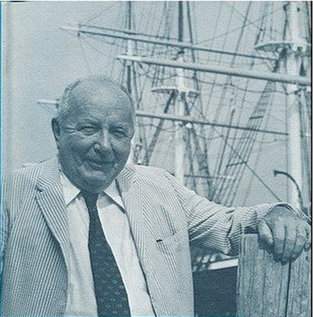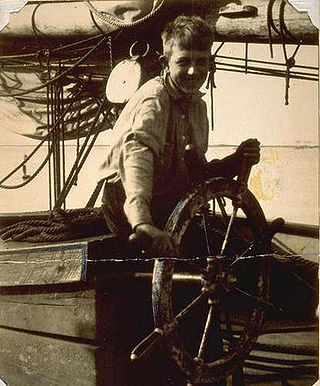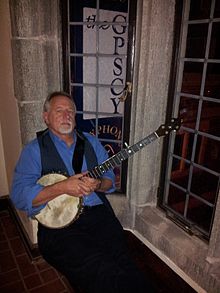
Mystic is a village and census-designated place (CDP) in Groton and Stonington, Connecticut.

Mystic Seaport Museum or Mystic Seaport: The Museum of America and the Sea in Mystic, Connecticut is the largest maritime museum in the United States. It is notable for its collection of sailing ships and boats and for the re-creation of the crafts and fabric of an entire 19th-century seafaring village. It consists of more than 60 historic buildings, most of them rare commercial structures moved to the 19-acre (0.077 km2) site and meticulously restored.

Joseph Conrad is an iron-hulled sailing ship, originally launched as Georg Stage in 1882 and used to train sailors in Denmark. After sailing around the world as a private yacht in 1934 she served as a training ship in the United States, and is now a museum ship at Mystic Seaport in Connecticut.

Charles W. Morgan is an American whaling ship built in 1841 that was active during the 19th and early 20th centuries. Ships of this type were used to harvest the blubber of whales for whale oil which was commonly used in lamps. Charles W. Morgan has served as a museum ship since the 1940s and is now an exhibit at the Mystic Seaport museum in Mystic, Connecticut. She is the world's oldest surviving (non-wrecked) merchant vessel, the only surviving wooden whaling ship from the 19th century American merchant fleet, and second to the USS Constitution, the oldest seaworthy vessel in the world. The Morgan was designated a National Historic Landmark in 1966.

The Mystic River is a 3.4-mile-long (5.5 km) estuary in the southeast corner of the U.S. state of Connecticut. Its main tributary is Whitford Brook. It empties into Fishers Island Sound, dividing the village of Mystic, Connecticut between the towns of Groton and Stonington. Much of the river is tidal. The Mystic River was the location of three large shipbuilding firms during the 19th-century, and it is now the home of the Mystic Seaport maritime museum. The name Mystic is derived from the Pequot term "missi-tuk", describing a large river whose waters are driven into waves by tides or wind, according to the Mystic River Historical Society.
Theodore Wilbur Houk(1907-1978) was a physician in Seattle, Washington during the mid 1900s. He was one of the first to use penicillin in the Pacific NW and was director of medical education at Providence Hospital in Seattle.

Robert Greenhalgh Albion was Harvard's first professor of Oceanic History and inspired two generations of maritime historians in the United States.

Mystic Seaport Light is a lighthouse at the south end of Mystic Seaport, 2 miles (3.2 km) upriver from Noank, Connecticut. The light is a two-story white shingled structured topped with a glass-enclosed lantern and is a replica of the 1901 Brant Point Light. The Mystic Seaport Light was designed by William F. Herman Jr. and constructed in 1966. It was formally dedicated on August 31, 1967, but remained unlit due to active navigational regulations imposed by the United States Coast Guard. The Mystic Seaport light is now an active light, but not an official aid to navigation.
Williams–Mystic, the Ocean and Coastal Studies Semester of Williams College and Mystic Seaport Museum, is an interdisciplinary semester program based at the Mystic Seaport Museum in Mystic, Connecticut.

Benjamin Woods Labaree was a leading historian of American colonial history and American maritime history. He was born in New Haven, Connecticut.

Sabino is a small wooden, coal-fired steamboat built in 1908 and located at the Mystic Seaport Museum in Mystic, Connecticut. It is one of only two surviving members of the American mosquito fleet, and it was declared a National Historic Landmark in 1992. It is America's oldest regularly operating coal-powered steamboat.

Emma C. Berry is a fishing sloop located at the Mystic Seaport Museum in Mystic, Connecticut, United States, and one of the oldest surviving commercial vessels in America. She is the last known surviving American well smack. This type of boat is also termed a sloop smack or Noank smack. The Noank design was imitated in other regions of the United States.
Captain Joseph Warren Holmes was an American sea captain noted for sailing around Cape Horn 84 times and Cape of Good Hope 14 times without a shipwreck or loss of a crewman. He had a 63-year career at sea, including 55 commanding clipper ships and others. He was the captain of more voyages around Cape Horn than anyone else.

John Faunce Leavitt (1905–1974) was a well-known shipbuilder, writer on maritime subjects, painter of marine canvases, and curator of Mystic Seaport in Mystic, Connecticut.
Dušan Kadlec was a Czech-Canadian painter, born in Humpolec, Czechoslovakia. He pursued his interest in art from a very early age, ultimately studying at the Academy of Fine Arts in Prague where he received a master's degree in 1967. His studies there covered twenty-two subjects, including bookbinding, papermaking, drawing, painting, portraiture, as well as the more conventional subjects of history, political economics, languages, and math. His undergraduate and graduate training focused on traditional painting techniques but also explored aspects of sculpture, jewellery design, art restoration, and architecture. While a student at the academy, he specialized in figurative painting and portraiture.

The Mystic Seaport Sea Music Festival, held annually in June from 1979 to 2020 at the Mystic Seaport Museum in Mystic, Connecticut, was among the oldest, and was the largest sea music festival in the United States. It reportedly attracted "the highest caliber of sea music performers, scholars, and fans." The Festival was first organized by Dr. Stuart M. Frank as a place to perform and hear sea music as well as a symposium for ethnomusicologists, anthropologists, and historians.

John Rousmaniere is an American writer and author of 30 historical. technical, and instructional books on sailing, yachting history, New York history, business history, and the histories of clubs, businesses, and other organizations. An authority on seamanship and boating safety, he has conducted tests of equipment and sailing skills, and led or participated in fact-finding inquiries into boating accidents. He has been presented with several awards for his writing and his contributions to boating safety and seamanship.
Forebitter is an American band with an international following specializing in sea shanties. It consists of four "chanteymen" employed by Mystic Seaport museum in Mystic, Connecticut, United States: Geoff Kaufman, Rick Spencer, David Littlefield, and Craig Edwards. The band has performed throughout the U.S., Canada and Europe.

J. Revell Carr is an American author, historian, curator and museum director.
Patrick Lyons O’Brien is an American artist and writer, known for his children's books and for his maritime paintings. The National Maritime Historical Society awarded O’Brien their Distinguished Service Award for his body of artwork in 2012.














